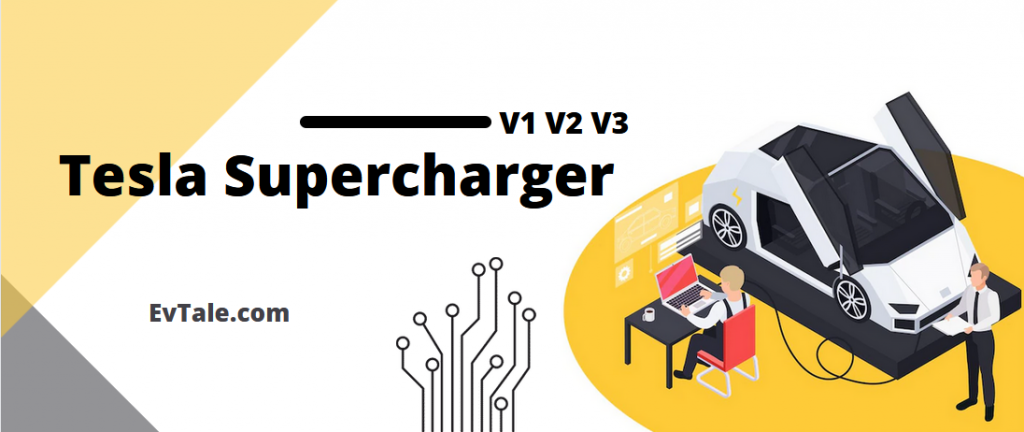A Tesla Supercharger is an electric car charger specifically for “fast charging.” In simpler words, they provide rapid recharging speeds, such as those capable of charging electric car batteries in under an hour.
There are three types of Supercharging stations on the market:
V1, V2, V3 Superchargers. V3 Supercharger are the most recent and advanced turbochargers, with charging speeds of up to 250 kW. Meanwhile, the V2 and V1 Charging stations were limited to lower 150 kW rates.
According to current rumors, V3 may be upgraded shortly, potentially giving up to 324kW speeds. However, aside from the highest charging speed, there are no significant differences between the various types of supercharging.
Although, since V1 and V2 stations are still in use, be aware that the maximum speed of 250 kW is not always available. Fortunately, Tesla’s turbocharger map makes it apparent what speeds are possible.
Differences Between Supercharger V1, V2 ,V3
Tesla’s global network of charger stations has long been seen as one of the company’s significant benefits in the plug-in car industry.

When Tesla’s first eight charger stations launched in 2012, these were always the fastest available in public charging technology that could charge an original 85 kWh Tesla Model S to empty to complete in around 75 minutes at energy levels of up to 90 kilowatts.
While EV superchargers were stunning at the time, they made long-distance car driving genuinely realistic and tolerable.
The Supercharging network debuted in 2012, with six stations around California. These could produce 90kw at first and increase to 120kw following a software upgrade.
V1 Supercharger
V1 charger is similar to the home charger or destination charger 240V 50Amp. Depending on the battery capacity of your EV, charging 80% of your car takes 8-10 hours.
If only one car is connected, V1 and V2 Superchargers could run at a maximum of 150kW DC, while more powerful V3 chargers can reach 250kW.
When a second Tesla connects to a fast charger, the maximum charging rate on the first car may decrease, even though the first car’s charge time is prioritised.
Charging rates for one automobile connected to an EV Charger vary based on the weather, the level of charge of a vehicle’s battery, and other factors.
V2 Supercharger
V2 now accounts for the majority of more than 15.000 chargers sold worldwide. These can produce up to 150kw. It takes approximately 30 minutes to charge to 80%. Each supercharger station is labelled A & B and shares power.
So, if you’re charging and someone pulls up next to you and plugs into the station to which your station is connected, your power supply is reduced to provide some electricity to the other car.
That’s why, before pulling it into a Supercharger stall, you should always check to see if you’ll be sharing power with the car parked next to you, and always aim to pick a turbocharger that’s not currently exchanging power with the station with which it’s associated.
According to Tesla, its Superchargers would be modified to support a maximum rate of 145kW “in the coming weeks.”
V3 Supercharger
V3 is faster than V2, but to fully use Tesla’s incredibly high-power capabilities of recharging up to 1,000 range miles per hour, you’ll have to pull onto your fast charger with a somewhat low state of charge.
When the car’s battery pack is more than 70% or 80% complete, the recharging power begins to decline, so the lesser power, the longer it takes to charge the car.
This is true for every single quick recharging vehicle on the market; if you want to optimise charging speed while minimising time, you always should arrive at a rapid charger with such a low state of battery.
It took 63.5 minutes from 0 to 100% on the V3 charger, but it only took approximately 6.5 minutes longer on the V2 station, and the entire charge took 1 hour and 10 minutes.
Even though its station produced significantly more energy until the 60% charge stage, it was never over 10% and 4 or 5 minutes behind the V2 station.
The new Supercharging stations’ most significant improvement is their separate 250 kW power supply for each station. Previous generation Superchargers have a single 150 kW backend shared by two recharging stalls.
What Could V4 Be Like In The Future?
It could be the new type of Supercharging post (V4). As previously stated, the V4 charger stall is planned to resemble the Megachargers. They will be slightly taller and thinner than that of the V3 charger but not relatively as high as Megachargers.
One of the most visible changes is that the wire is now situated outside the pedestal instead of inside it, as it was. It looks to result in a more significant connection length required to handle non-Tesla Vehicles.
The upcoming V4 version is also predicted to have a more powerful output than the other chargers, while no official information is available. On the other hand, the existing Tesla Superchargers are believed to receive a considerable power boost from 250 kW to 324 kW. (peak).

Conclusion : Supercharger V1, V2 ,V3
In general, the slower the charge, the older the vehicle. However, numerous factors come into play while deciding the battery recharging speed.
Your car and the Superchargers interact to determine the best recharging rate for your vehicle.
The supercharging rate may vary depending on the current battery level, usage of the Supercharger station, and adverse weather conditions.
Your vehicle charges faster whenever the battery is at a low state of charge, and the charger slows as it fills up. Depending on your location, recharging to maximum capacity is not always necessary.